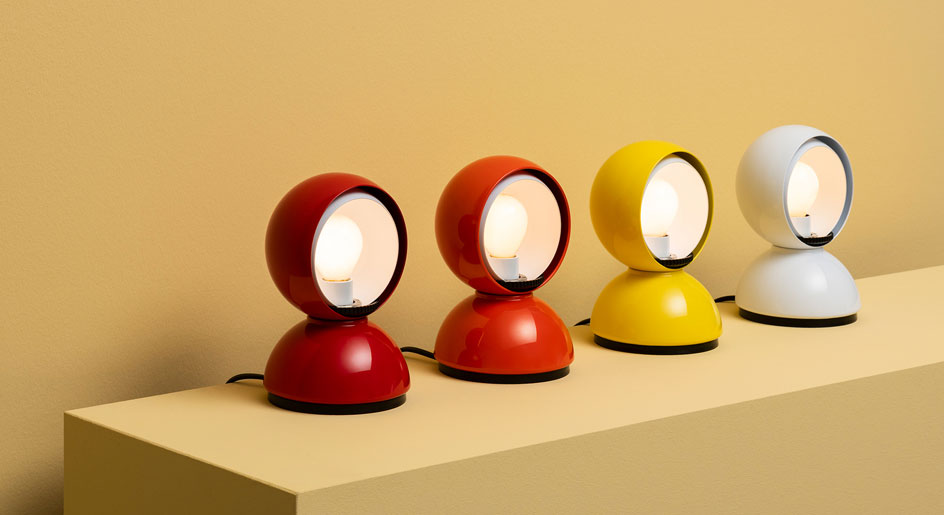
Design by Decade 1960's
The ‘60s were a time for self-expression, rejection of the establishment, and a departure from tradition. The Space Race, the Civil Rights movement, and Vietnam War protests dominated the headlines while the rise of mod style, hippie culture, pop art, and psychedelia pushed the boundaries of acceptable social norms. As a result, vibrant colors and exploratory shapes and materials made their way into homes. Both Art Deco and Art Nouveau re-emerged, with geometric patterns and free flowing forms seen in equal measure. The most pervasive theme of the decade was futuristic, space age design, with elements of organic motifs thrown into the mix.
Moon Pendant (1960)
by Verpan
Moon is one of the earliest light fixtures designed by the prolific and highly influential Danish visionary, Verner Panton. A masterful example of avant-garde futurism, Moon both looks and acts the part of a space age furnishing. Moon’s concentric reflective shades can move to expose, conceal, or partially obscure the central bulb – the shape of the fixture and the quality of its light can wax and wane, just like its namesake.
Shop Now
Splugen Brau Suspension (1961)
by Flos
Mastering the art of space age, futuristic minimalism, the Castiglioni brothers originally designed this pendant for Milan’s Splugen Brau brewhouse and restaurant in 1961. Flos put this icon of Italian mid-century design into production in 1964. The highly polished spun aluminum reflector is protected by a layer of glossy, transparent paint that enhances the fluidity of it ripple-like design.
Show Now
Blom Table Lamp
by Fontana Arte
Though it’s not technically from the ‘60s, Andreas Engesvik’s Blom table lamp for FontanaArte looks like it’s straight from the set of a Stanley Kubrick film. Bright, bold, floral – it’s the veritable flower child of the lighting world, despite its birth in 2013. Clean, Scandinavian lines and a wide color palette of green, red and yellow make the Blom a far out statement piece that looks just as groovy off as it does turned on.
Shop Now
Fun 1DM Pendant (1964)
by Jonathan Adler
Another Verner Panton creation, Fun captures the playful and exploratory spirit of design in the 1960s. Panton’s experimental creations were a dramatic deviation from the prevailing minimalism of his Scandinavian contemporaries, a departure that mirrored the ongoing US shift from sober modernism towards colorful self-expression. The original metal pendant evokes space age design, while the capiz shell versions offer organic, earthy style reminiscent of bohemian beaded curtains.
Shop Now
Eclisse Table Lamp (1966)
by Artemide
The Eclisse table lamp is perhaps the most famous of all lamps from the 1960s and one of the most significant industrial design products of the 20th century. Designed by Vico Magistretti for Artemide in 1966, the Eclisse is on permanent display at museums around the world and still sells today. Shown here in a flamboyant orange, the lamp also demonstrates the decade’s fondness for color and flair.
Shop Now
Spun Light T Table Lamp
by Flos
Designed in 2003 by Sebastian Wrong, the Spun Light T Table Lamp is a studied throwback to 1960s style. Free flowing curves and shapes were incredibly popular in the ‘60s, inspired by Eero Saarinen’s seminal “Pedestal” furniture series (1956). Although Spun’s metal frame and diffuser would more likely have been made of plastic in the ‘60s, its dynamic fluid aesthetic and simple elegance would have been right at home.
Shop Now
-
What were some of the most iconic lighting designs of the 1960s?
-
How did the Space Age and futurism influence 1960s lighting aesthetics?
-
What materials and manufacturing techniques were popular for 60s light fixtures?
-
How did the introduction of halogen lighting affect fixture design in the 60s?
-
How can you incorporate vintage 1960s lighting into contemporary spaces?













